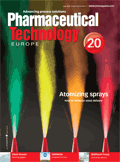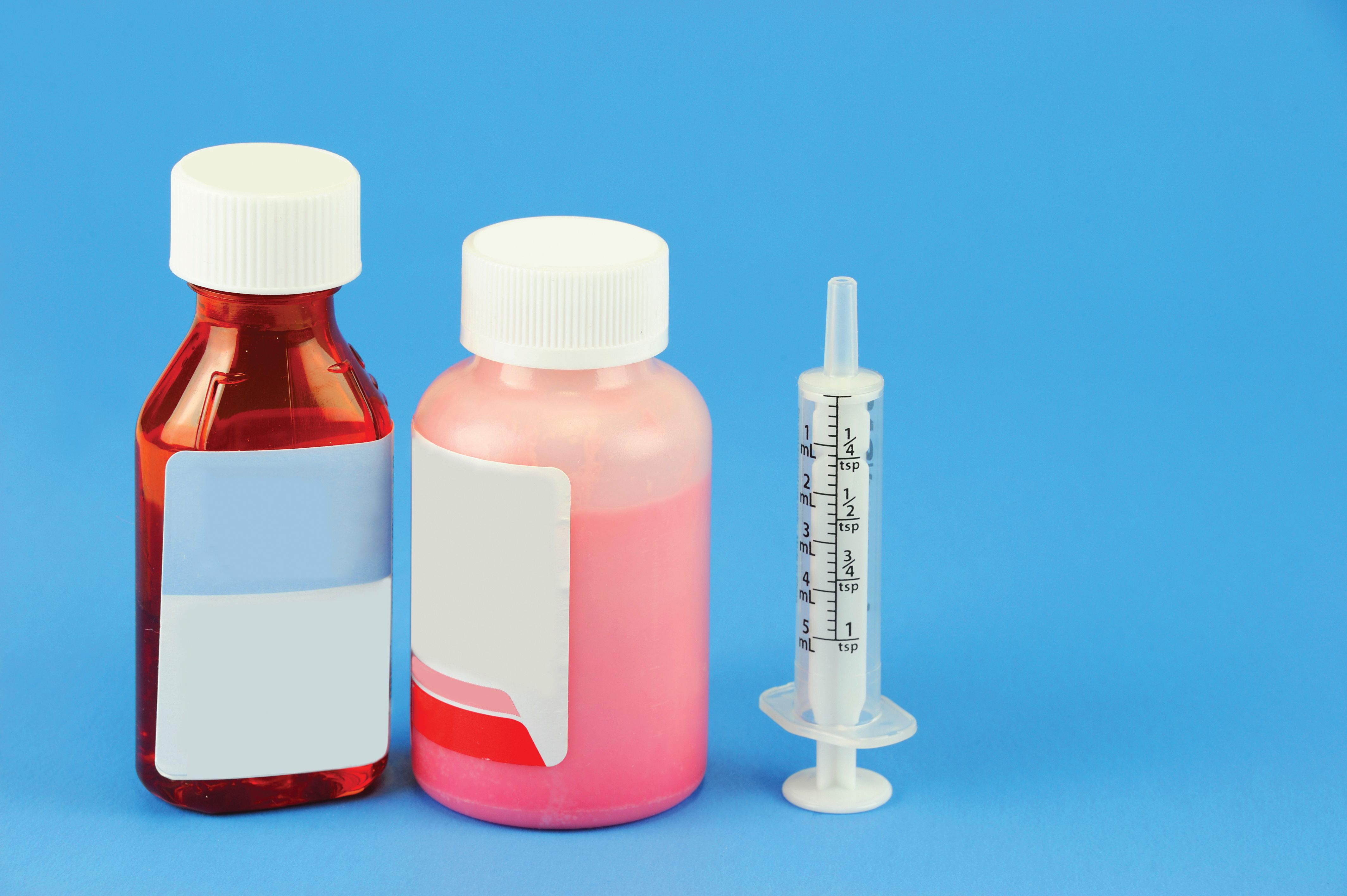News
Article
Pharmaceutical Technology Europe
Pharmaceutical Technology Europe
Enhancing the in vitro assessment of nasal sprays
Author(s):
Nasal drug delivery depends on many factors, including the conditions of use by the patient, the drug formulation, and the spray pump and aerosol characteristics. In recent years, the types of drug administered via the nasal route have expanded from locally acting drugs, such as those for allergic rhinitis, to delicate molecules for systemic activity, such as vaccines, proteins and peptides, which can be difficult to administer noninvasively. While the nasal cavity provides a delivery pathway for these large molecules, the rate of mucociliary clearance in the nasal cavity may hinder the extent of absorption. Therefore, formulators must develop mechanisms that improve absorption for high molecular weight compounds.
Nasal drug delivery depends on many factors, including the conditions of use by the patient, the drug formulation, and the spray pump and aerosol characteristics. In recent years, the types of drug administered via the nasal route have expanded from locally acting drugs, such as those for allergic rhinitis, to delicate molecules for systemic activity, such as vaccines, proteins and peptides, which can be difficult to administer noninvasively. While the nasal cavity provides a delivery pathway for these large molecules, the rate of mucociliary clearance in the nasal cavity may hinder the extent of absorption. Therefore, formulators must develop mechanisms that improve absorption for high molecular weight compounds.
Formulation
As with all in vivo preparations, nasally administered drugs require a consistent and reproducible dose. Unlike a tablet, the dosing of a nasal spray must be achieved using a mechanical device. In addition, the device may deliver up to 200 doses compared with a single dose contained in a tablet. Therefore, enhancing the consistency of dose delivery to nasal sites of action requires the formulation characteristics and delivery device capabilities to be harmonized. Formulation researchers have recently explored new methods of delivering macromolecules nasally by using delivery systems such as liposomes, microspheres and gels, as well as applying bioadhesive additives such as chitosan and other ingredients to improve absorption via prolonged retention on the nasal mucosa.1–3 Other ingredients have also been used to increase the viscosity of formulations, with the goal of improving product stability during storage and increasing residence time of the formulation within the nasal passages following delivery.
For the formulator, the broad range of options that may be included as ingredients in a nasal spray presents many challenges; for instance, the addition of excipients can aid drug retention or absorption following delivery, but may also have a significant effect on the properties of the spray plume, affecting the deposition site of the aerosol. Guo demonstrated using a nasal cast that nasal sprays with a low viscosity provided greater surface coverage than higher viscosity formulations, with this being related to the particle size and, possibly, the plume geometry.4
Other studies have also confirmed the importance of the geometry of the nasal passages and the properties of the spray plume in influencing spray deposition.5–8 Guo concluded that "spray pattern, plume geometry and droplet size distribution all appeared to provide critical data for the assessment of nasal pump performance,"9 as it related to reproducible delivery from the device. Therefore, droplet size measurements, along with plume pattern and geometry assessments provide an in vitro test that can be used to understand the performance of the delivery device and how this is affected by changes to the formulation. These methods (with the exception of plume geometry) are also used as quality control tests.
This study examines the in vitro performance of different polymers, which may be used to improve stability or prolong retention, in model nasal spray formulations. Viscosity and droplet size were used to assess performance from a commercially available nasal spray device.
Methods
This study concentrates on two areas of measurement that are key concerns when developing a nasal spray product: rheological measurement (including viscosity and yield stress) and droplet size distribution. Two different formulations were studied to examine how the rheological properties affect liquid atomization. One of these was a model formulation where the concentration of polyvinylpyrrolidone (PVP) in water was changed to yield different plume characteristics. PVP was used in this study as it increases the Newtonian viscosity with only a small change to the elasticity of the sample, allowing measurement of the effect of viscosity change on the droplet size. The second formulation related to an over-the-counter product where carboxymethylcellulose and microcrystalline cellulose (CMC/MCC) had been added to impart thixotropic behaviour to prevent the product from dripping back out of the nose after administration. Each formulation was delivered using a VP3 nasal spray pump actuator (Valois, France). The two formulations were characterized using a Spraytec laser diffraction particle sizing system and a Bohlin Gemini HR Nano Rheometer (both Malvern Instruments, UK).
Assessment using laser diffraction
The FDA's draft guidance for industry, 'Bioavailability and Bioequivalence Studies for Nasal Aerosols and Nasal Sprays for Local Action', recommends how nasal sprays should be measured in vitro.10 This includes the use of laser diffraction particle sizing to assess how spray atomization is achieved. FDA also recommends that in vitro measurements be conducted using an automatic means of actuating the nasal pump, as it eliminates the possibility of differences in results caused by human actuation.
Very rapid data acquisition rates are possible using a laser diffraction system for nasal spray analysis. This allows changes in particle size during single device actuations to be measured. From this, the different 'phases' of atomization can be assessed.11 FDA recommends that the fully developed phase of atomization, where the concentration and particle size of the spray is relatively constant, be identified. This can then be compared for different formulations.
Rheological measurement
Although rheological assessment of nasal spray formulations is not referenced in the FDA guidance document, it is essential to the development of an efficient and effective product, and is included in FDA's Chemistry, Manufacturing and Controls guidance for nasal spray products.12 For some formulations, especially those based on suspensions, it can be advantageous if the formulation displays high viscosity at low shear rates, as it can confer stability during storage and improve the spray content uniformity. Upon the application of high shear rates, such as can be experienced during shaking or atomization, the product should exhibit thixotropic properties to provide a low viscosity liquid that may be easily atomized.
On deposition in the nasal cavity, the formulation should quickly become viscous again to slow the rate of clearance from the nose. Using a rheometer, it is possible to mimic each of these situations by measuring the changes in viscosity that occur as the shear rate applied to a formulation is increased. This, in turn, can be used to understand how the addition of polymers to a product affects atomization characteristics.13,14
Case study: Newtonian solutions
To understand how changes in the Newtonian viscosity of a formulation affect nasal spray performance, the atomization performance of PVP solutions was monitored for actuation using the VP3 pump actuator. PVP concentrations of 0.25–1.5% were studied. Actuation of the device was controlled using a velocity-controlled actuator (SprayVIEW NSx; Proveris Scientific, MA, USA) using a velocity of 40–100 mm/s and an acceleration of 5000 mm/s2.
The rheology test results for the model formulations produced using PVP confirm that the viscosity of the solution increases with the concentration of PVP. No shear dependence of the viscosity is observed, which confirms that these solutions are Newtonian.
The median (Dv50) droplet size produced during the stable phase of actuation of pumps containing each of the PVP solutions is shown in Figure 1 for different actuation velocities. For actuation velocities of ≥70 mm/s, a steady increase in the observed particle size is seen, mirroring the changes in viscosity. A similar trend is seen at 40 mm/s for the low viscosity solutions (≤0.5% PVP). However, a significant increase in particle size is observed at 40 mm/s when increasing the PVP concentration from 0.5% to 1.0%. This suggests that complete atomization of the liquid is not achieved at high PVP concentrations when using a low actuation velocity.
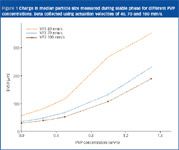
Figure 1
The poor atomization performance observed at high polymer concentrations can be easily seen in the size history profiles obtained for actuation of the pump at 40 mm/s (Figure 2). At polymer concentrations of ≤0.5%, an obvious 'fully-developed' phase is observed, suggesting that liquid break-up is well controlled. However, at higher concentrations the flow velocity of the formulation through the pump nozzle is not high enough to overcome the liquid's viscosity. In the case of the atomization of the 1% PVP solution, the flow velocity is only sufficient to achieve complete break-up towards the end of the actuation process, whereas at 1.5% complete break-up is not observed at all.

Figure 2
Case study: thixotropic formulations
Adding CMC and MCC to a formulation increases the viscosity and leads to the formation of structure within the liquid. This causes the formulation to become thixotropic, with the viscosity at low shear rates being significantly greater than at high shear rates. This can have a significant effect on the atomization performance of a formulation.
An example of the changes that occur upon addition of CMC/MCC can be seen in Figure 3. Here, the change in viscosity is shown for two nasal spray products — these are identical apart from the fact that one (Formulation 2) contains ~3% of a CMC/MCC blend. Addition of the polymer significantly modifies the formulation so that it becomes thixotropic instead of Newtonian. This suggests the formation of some form of structure within the liquid during storage.
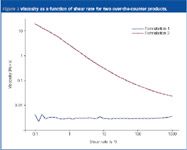
Figure 3
The nature of the structure present in Formulation 2 can be understood by observing how the viscosity changes when it is subjected to rapid changes in shear, as shown in Figure 4. For this experiment, the formulation was initially placed under shear at a rate of 1 s-1. After 30 s, the shear rate was increased to 100 s-1, causing the viscosity to decrease significantly to only 2% of its low shear value. This suggests that a rapid breakdown in the structure occurs when this product is placed under high shear. After a further 30 s, the shear rate was reduced to 1 s-1 again, at which point the viscosity increased. The viscosity did not immediately return to the previously recorded low shear value and, instead, followed an initial rapid change. The viscosity slowly increased such that after 2 min it attained a level that was approximately two thirds of the initial value measured at a shear rate of 1 s-1. This is indicative of the rebuilding of the polymer structure within the liquid following the application of high shear.
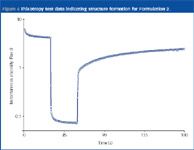
Figure 4
The effect of the above on atomization performance using the VP3 pump actuator is significant. Formulation 1 shows good atomization performance with a range of actuation velocities, indicating that droplet break-up is easily achieved (Table 1). By contrast, Formulation 2 shows extremely poor atomization at low actuation velocities. However, once the velocity reaches a critical point, complete atomization is immediately observed (Figure 5). This correlates to the point where the shear experienced during atomization is able to break down the structure formed by the CMC/MCC polymers. The particle size remains larger than for Formulation 1 because of the higher viscosity of this formulation, even at high shear rates.

Figure 5
Conclusion
These studies demonstrate a significant relationship between the rheological properties of a formulation and the way in which atomization occurs during actuation of a nasal pump spray. A combination of laser diffraction droplet sizing and rheological testing could aid researchers in understanding how the function of nasal spray products alters with changes in formulation.

Table 1 Median particle size recorded for the stable phase of actuation for Formulations 1 and 2. Formulation 2 contains CMC.
The results show that, for both Newtonian and thixotropic formulations, increasing the viscosity increases the droplet size. In addition, rheological changes have an impact on the duration of the stable phase, and affect the sensitivity of the measured stable phase particle size to changes in the actuation velocity. This, in turn, may influence the achieved site of deposition for different patient groups. Selecting the correct concentration of polymer for use as a viscosity modifier is critically important in delivering consistent droplet size, and to the production of a reliable and efficacious product.
Paul Kippax is Product Manager, Diffraction Products at Malvern Instruments (UK). www.malvern.com
Julie D. Suman is President at Next Breath LLC (MD, USA). www.nextbreath.com
Gerallt Williams is Director R&D Laboratory Services at Valois SAS (France). www.valois.com
References
1. S.S. Davis and L. Illum, Clin. Pharmacokinet., 42(13), 1107–1124 (2003).
2. L. Illum, Drug Discovery Today, 7(23), 1184–1189 (2002).
3. C. Callens et al., J. Pharm. Biopharm., 55(3), 323–328 (2003).
4. Y. Guo, B. Laube and R. Dalby, Pharm. Res., 22(11), 1871–1878 (2005).
5. H. Kublick and M.T. Vidgren, Adv. Drug Del. Rev., 29(1–2), 157–177 (1998).
6. Y.S. Cheng et al., J. Aerosol Med., 14(2), 267–280 (2001).
7. J.D. Suman, B.L. Laube and R.N. Dalby, Pharm. Res., 16(10), 1648–1652 (1999).
8. S.P. Newman, G.R. Pitcairn and R.N. Dalby, Crit. Rev. Ther. Drug Carrier Sys., 21(1), 21–66 (2004).
9. C. Guo and W.H. Doub, J. Pharm. Sci., 95(9), 2029–2040 (2006).
10. FDA Draft Guidance for Industry — Bioavailability and Bioequivalence Studies for Nasal Aerosols and Nasal Sprays for Local Action, April 2003. www.fda.gov
11. P. Kippax and A. Virden, Pharmaceutical Formulation and Quality, (July/August), 32–35 (2007).
12. FDA Guidance for Industry — Nasal Spray and Inhalation Solution, Suspension, and Spray Drug Products — Chemistry, Manufacturing, and Controls Documentation, July 2002. www.fda.gov
13. P. Dayal, M.S. Shaik and M. Singh, J. Pharm. Sci., 93(7), 1725–1742 (2004).
14. G.M. Eccleston et al., Drug Dev. Ind. Pharm., 26(9), 975–983 (2000).
Newsletter
Get the essential updates shaping the future of pharma manufacturing and compliance—subscribe today to Pharmaceutical Technology and never miss a breakthrough.
